|
Journal of a Sabbatical |
|||||||
|
May 25, 2000 |
|
light and dark |
|||||
|
|
|
|
|||||
|
Official plover count: Today's Bird Sightings: 3 cedar waxwings Today's Reading: The Birds of
Brewery Creek by Malcolm MacDonald, Today's Starting Pitcher: Plum Island Bird List
Copyright © 2000, Janet I. Egan |
|
The storm continues until I get to Joppa Flats. Then
suddenly the sky is bright blue. The air is hot and humid
like a steam bath. Steam rises from the salt
marsh.
A male redwing blackbird cavorts on top of a pile of salt marsh straw, catching bugs and offering tidbits to a female who blends in with the beach detritus really well. A catbird hangs around with the redwing blackbirds, hopping around on the beach. I have never seen a catbird hop around on the beach before. The catbird mostly mews, but it does break into fragments of mimicry every once in awhile. Swallows of various kinds are all over the place skimming low over the sand catching bugs. They move so fast and fly so low it's hard to sort them out. There are almost no visitors around even though this is
supposed to be the first nice day in a very long time. I see
blue sky and puffy white clouds to the south. I'm so engaged
in watching the birds that I don't notice the ominous black
sky to Back on the beach, the swallows are gone. Not a one remains. The yellow warbler pair and the redwing blackbird pair continue their antics in almost the same spot as before the the thunderstorm. The swallow man asks if I've seen any ruddy turnstones. I tell him there's a large flock of shorebirds just out of binocular range that could be a combination of ruddy turnstones and black bellied plovers but they're not close enough to sort out yet. He goes off to look for the bank swallows. A flock of Bonaparte's gulls lands on the beach just to the south of where I'm sitting. The shorebird flock moves closer and I see it's about evenly divided between black bellied plovers and ruddy turnstones. I watch them for awhile, talk to a couple of visitors, watch them some more. They take off, swirl around, and then land right at the edge of the rock pile. We're talking close. I examine every individual in detail and notice one of these birds is not like the others, one of these birds doesn't belong ... It's a red knot. I've always wanted to see a red knot on the refuge. Cool. I start walking closer to the rocks and see the swallow guy looking in the direction of the red knot also. He asks me: "Do you see a knot there?" "Umm,yeah, on that rock right next to the black bellied plover." Made his day too. A few minutes before the end of my shift, the refuge biologist roars by on the ATV and hollers out to me that she counted 9 pairs and 4 nests already incubating. Don't know what the others are waiting for. C'mon, little endangered beasties, reproduce yourselves. |
|||||
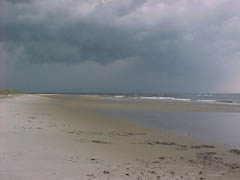 I
believed the weather forecast that the rain is over. Indeed
it isn't raining when I leave the house. I stop for a bagel
and as I return to my car I hear a thunderclap. A really
loud thunderclap. Moments later the heavens open up. By the
time I get onto the highway I can't see the road. Why am I
driving to the beach? Why is the radio weather person
telling me the rain is finally over and it's a gorgeous
bright spring day? Where is this radio station? Obviously
not on 495.
I
believed the weather forecast that the rain is over. Indeed
it isn't raining when I leave the house. I stop for a bagel
and as I return to my car I hear a thunderclap. A really
loud thunderclap. Moments later the heavens open up. By the
time I get onto the highway I can't see the road. Why am I
driving to the beach? Why is the radio weather person
telling me the rain is finally over and it's a gorgeous
bright spring day? Where is this radio station? Obviously
not on 495.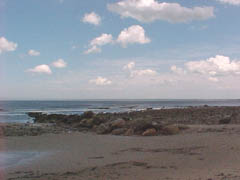 The trip from the gatehouse to the south end of the island
is like something out of a dream. Everything is brilliantly
clean and shines like it was just created this morning.
Birds are everywhere singing like crazy. One skinny little
bare tree by the Hellcat parking lot held 3 cedar waxwings,
a pair of purple finches, and a cat bird all singing. Cat
birds were all over the place. It seemed like every little
shrub had a cat bird in it and every patch of grass had a
bobolink. A bobolink flew alongside my car for a quarter of
a mile, vocalizing at top volume all the way.
The trip from the gatehouse to the south end of the island
is like something out of a dream. Everything is brilliantly
clean and shines like it was just created this morning.
Birds are everywhere singing like crazy. One skinny little
bare tree by the Hellcat parking lot held 3 cedar waxwings,
a pair of purple finches, and a cat bird all singing. Cat
birds were all over the place. It seemed like every little
shrub had a cat bird in it and every patch of grass had a
bobolink. A bobolink flew alongside my car for a quarter of
a mile, vocalizing at top volume all the way.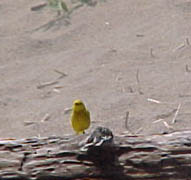 This
amazing amount of bird activity continues on the beach -
once I finally get there. Without even trying I see 23
species just from my spot on the beach. Two yellow warblers
spend the whole shift with me on the beach. They are
evidently a pair, as the male keeps offering little tidbits
to the female. They chase each other back and forth from the
wrack line to the dunes.
This
amazing amount of bird activity continues on the beach -
once I finally get there. Without even trying I see 23
species just from my spot on the beach. Two yellow warblers
spend the whole shift with me on the beach. They are
evidently a pair, as the male keeps offering little tidbits
to the female. They chase each other back and forth from the
wrack line to the dunes.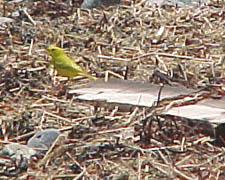 Sometimes they land on a log right behind me. The male
almost lands on my backpack but thinks better of it. I don't
know if it's the sunscreen or the bug repellent he doesn't
like.
Sometimes they land on a log right behind me. The male
almost lands on my backpack but thinks better of it. I don't
know if it's the sunscreen or the bug repellent he doesn't
like.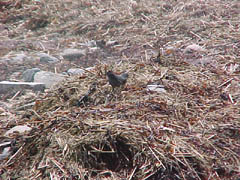 the
northwest until the storm is almost on top of me. I'm
talking with a visitor who has come to look for bank
swallows when thunder roars and a few big raindrops fall. I
head for my car to wait out the storm, as does the swallow
man. The heavens open up and I can't help getting wet.
Twenty minutes later, the sky is blue again.
the
northwest until the storm is almost on top of me. I'm
talking with a visitor who has come to look for bank
swallows when thunder roars and a few big raindrops fall. I
head for my car to wait out the storm, as does the swallow
man. The heavens open up and I can't help getting wet.
Twenty minutes later, the sky is blue again.